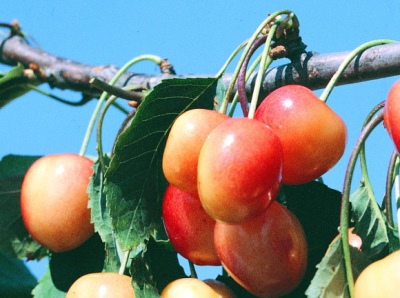
- Fruit shape: heart-shaped
- Authors: Belarus
- Growth type: vigorous
- Appointment: universal
- Yield: high
- Crown: wide, raised, of medium density
- Sheet: large, elongated, narrow oval, long-pointed, green, slightly wrinkled, leaf edge double-serrate
- Fruit size: large
- Fruit weight, g: 7
- Fruit color: the main color is light yellow, the integumentary color is red
Belle is a versatile sweet cherry variety bred by Belarusian breeders as a result of free pollination of the American Ohio Belle. In Russia, the variety is quite popular and well studied.
Description of the variety
The Beauty's tree is distinguished by its great vigor of growth, its crown is wide-rounded, raised, of medium density. The leaves are characterized by an elongated narrow oval shape. The leaf plate is green, slightly wrinkled. Fruits are formed on bouquet branches.
Fruit characteristics
The berries are large, weighing on average 7 g, develop in the shape of a heart with a light yellow and integumentary red skin with a strong waxy coating.
Taste qualities
The light yellow pulp is very juicy, gristly, sweet, when biting, a rich light yellow juice flows out, the taste is estimated at 4.8 points. The small bone is easily separated from the pulp. Berries are suitable both for fresh consumption and for making juice, compote, jam.
Ripening and fruiting
The first fruits can be enjoyed in the third year after planting on seed stock. The tree begins to bloom in May, and the harvest can be harvested in late June or early July, which is typical for varieties with an average ripening period.

Yield
It is a high-yielding variety that can produce an average of 16 tons of berries per hectare.
Self-fertility and the need for pollinators
The beauty is a partially self-fertile variety that needs pollinating neighbors for active fruiting. Such varieties as Zhurba and Northern cherry have proved their effectiveness as pollinators for Beauty.
Growing and care
Pay special attention to the variety even at the planting stage. So, choose for planting a sunny area with deep groundwater and fertile, well-drained soil. For group planting, plant seedlings according to the 5x3 m scheme.
When cultivating, it is important to responsibly approach the following processes.
Fertilizer
Top dressing is applied twice a year. In the spring, organic matter is used, but note that if the fertilizer is rotten, the tree's immunity to diseases will decrease. In the fall, mineral compositions are more suitable. It is very good if a lot of worms settle in the ground - they loosen and soften the trunk circle and make the soil more fertile.
Watering
The beauty needs moderate irrigation. In a dry season, water the tree 2-4 times a month, and if it rains, then, in general, do not moisten the soil. In the fall, watering is not needed at all.
Pruning
Formative pruning is carried out from the first year of life, after the fifth year, branches growing inward can be removed and skeletal branches can be shortened.Sanitary pruning is carried out in spring and autumn and consists in the elimination of old, frozen, diseased branches.
Preparing for winter
The Krasavitsa variety is considered winter-hardy, but practice shows that the plant can freeze out, so it needs to be helped to survive the harsh time. So, in late autumn, warm the trunk circle, and in the first year, wrap the seedling with protective material for the winter. Make sure that mice and other rodents do not chew on the bark during the winter.




Disease and pest resistance
The Krasavitsa variety has a high immunity against such ailments as coccomycosis and moniliosis, but occasionally it can be affected by fungal infections. To reduce the risk of illness, take the following preventive measures:
treat the tree in spring with Bordeaux liquid or copper sulfate;
prevent water stagnation and overflow;
remove fallen leaves, branches and fruits in time;
during pruning, process the cuts with garden pitch.


Review overview
The gardeners appreciated the taste of the Krasavitsa variety highly, but agricultural technology does not seem simple to them. According to gardeners, the variety is not suitable for beginners, as it requires a special approach to cultivation. But all the work is rewarded with a high yield of delicious juicy berries.































































